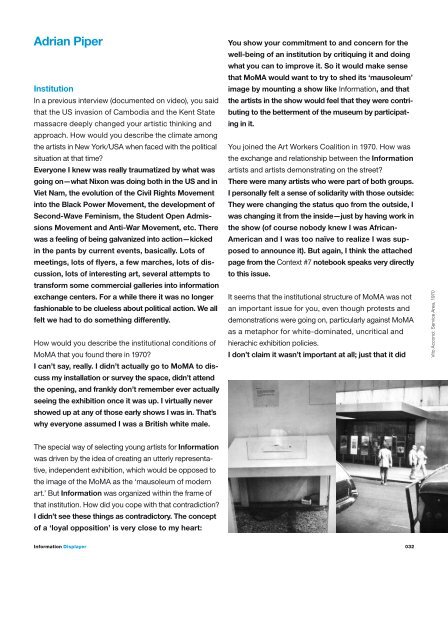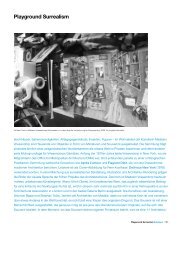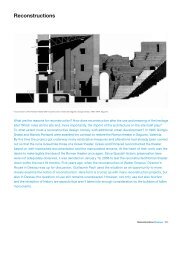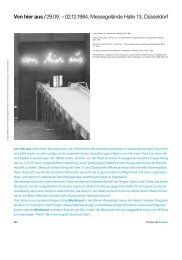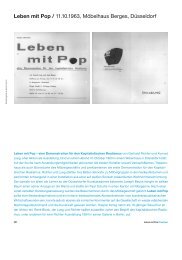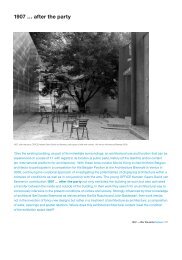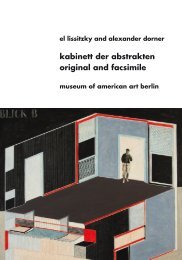Information / 02.07. â 20.09.1970, Museum of Modern Art, New York
Information / 02.07. â 20.09.1970, Museum of Modern Art, New York
Information / 02.07. â 20.09.1970, Museum of Modern Art, New York
Sie wollen auch ein ePaper? Erhöhen Sie die Reichweite Ihrer Titel.
YUMPU macht aus Druck-PDFs automatisch weboptimierte ePaper, die Google liebt.
Adrian Piper<br />
Institution<br />
In a previous interview (documented on video), you said<br />
that the US invasion <strong>of</strong> Cambodia and the Kent State<br />
massacre deeply changed your artistic thinking and<br />
approach. How would you describe the climate among<br />
the artists in <strong>New</strong> <strong>York</strong>/USA when faced with the political<br />
situation at that time<br />
Everyone I knew was really traumatized by what was<br />
going on—what Nixon was doing both in the US and in<br />
Viet Nam, the evolution <strong>of</strong> the Civil Rights Movement<br />
into the Black Power Movement, the development <strong>of</strong><br />
Second-Wave Feminism, the Student Open Admissions<br />
Movement and Anti-War Movement, etc. There<br />
was a feeling <strong>of</strong> being galvanized into action—kicked<br />
in the pants by current events, basically. Lots <strong>of</strong><br />
meetings, lots <strong>of</strong> flyers, a few marches, lots <strong>of</strong> discussion,<br />
lots <strong>of</strong> interesting art, several attempts to<br />
transform some commercial galleries into information<br />
exchange centers. For a while there it was no longer<br />
fashionable to be clueless about political action. We all<br />
felt we had to do something differently.<br />
How would you describe the institutional conditions <strong>of</strong><br />
MoMA that you found there in 1970<br />
I can’t say, really. I didn’t actually go to MoMA to discuss<br />
my installation or survey the space, didn’t attend<br />
the opening, and frankly don’t remember ever actually<br />
seeing the exhibition once it was up. I virtually never<br />
showed up at any <strong>of</strong> those early shows I was in. That’s<br />
why everyone assumed I was a British white male.<br />
The special way <strong>of</strong> selecting young artists for <strong>Information</strong><br />
was driven by the idea <strong>of</strong> creating an utterly representative,<br />
independent exhibition, which would be opposed to<br />
the image <strong>of</strong> the MoMA as the ‘mausoleum <strong>of</strong> modern<br />
art.’ But <strong>Information</strong> was organized within the frame <strong>of</strong><br />
that institution. How did you cope with that contradiction<br />
I didn’t see these things as contradictory. The concept<br />
<strong>of</strong> a ‘loyal opposition’ is very close to my heart:<br />
You show your commitment to and concern for the<br />
well-being <strong>of</strong> an institution by critiquing it and doing<br />
what you can to improve it. So it would make sense<br />
that MoMA would want to try to shed its ‘mausoleum’<br />
image by mounting a show like <strong>Information</strong>, and that<br />
the artists in the show would feel that they were contributing<br />
to the betterment <strong>of</strong> the museum by participating<br />
in it.<br />
You joined the <strong>Art</strong> Workers Coalition in 1970. How was<br />
the exchange and relationship between the <strong>Information</strong><br />
artists and artists demonstrating on the street<br />
There were many artists who were part <strong>of</strong> both groups.<br />
I personally felt a sense <strong>of</strong> solidarity with those outside:<br />
They were changing the status quo from the outside, I<br />
was changing it from the inside—just by having work in<br />
the show (<strong>of</strong> course nobody knew I was African-<br />
American and I was too naïve to realize I was supposed<br />
to announce it). But again, I think the attached<br />
page from the Context #7 notebook speaks very directly<br />
to this issue.<br />
It seems that the institutional structure <strong>of</strong> MoMA was not<br />
an important issue for you, even though protests and<br />
demonstrations were going on, particularly against MoMA<br />
as a metaphor for white-dominated, uncritical and<br />
hierachic exhibition policies.<br />
I don’t claim it wasn’t important at all; just that it did<br />
Vito Acconci: Service Area, 1970<br />
Vito Acconci: Service Area, 1970<br />
not significantly affect the work I would have submitted<br />
for the show. Protests were going on about everything:<br />
the Viet Nam war, Nixon‘s invasion <strong>of</strong> Cambodia,<br />
sexism, racism, the shooting by the National Guard <strong>of</strong><br />
students at Kent State and Jackson State Universities.<br />
MoMA was only one <strong>of</strong> many such institutions that<br />
were targets <strong>of</strong> protest, some as metaphors, some as<br />
realities. My essay, Three Models <strong>of</strong> <strong>Art</strong> Production<br />
Systems (1970), addressed the impact <strong>of</strong> all <strong>of</strong> those<br />
events on the creative process. MoMA was just one<br />
example.<br />
It would not have had the same presence in an alternative<br />
art space <strong>of</strong> that time.<br />
Yes, I agree. It gave the show and the aesthetic values<br />
presented in it a level <strong>of</strong> visibility and institutional<br />
legitimacy it would not have had in an alternative<br />
space. But keep in mind that it came only after several<br />
such survey shows had already been done in Europe—<br />
and, for that matter, in the US.<br />
<strong>Information</strong> made links between artworks, which one<br />
could classify as ‘institutional critique,’ and upcoming<br />
information-technologies. But while the latter have<br />
evolved a lot since <strong>Information</strong>, when people talk <strong>of</strong><br />
institutional critique, it seems that its climax has already<br />
passed. Why is that<br />
The reason we critique institutions is because we’re<br />
annoyed that we’re not in-group members <strong>of</strong> them.<br />
The best way to shut up an institutional critic is to give<br />
her a job in the institution she’s critiquing.<br />
When Les Levine wrote in The <strong>Information</strong> Fallout (1971),<br />
that the MoMA had increased its power by showing its<br />
‘enemies’ (critical artists), he said that, from his point <strong>of</strong><br />
view, <strong>Information</strong> could have been part <strong>of</strong> a strategy<br />
against institutional critique. What is your perspective<br />
on his statement<br />
I think that statement ascribes way too much<br />
intelligence to institutions. I’m sure MoMA just wanted<br />
to draw a good crowd and make money.<br />
Institution – <strong>Art</strong>ist<br />
While the curator and the institution remained in the background,<br />
artists like yourself, Vito Acconci, Hans Haacke<br />
and others worked with active participation <strong>of</strong> the public<br />
gaining as well visibility as responsibility. How do you<br />
remember and where do you see the specific constellation<br />
<strong>of</strong> <strong>Information</strong> in regard to the relation between the<br />
artists, the institution and the public How do you see<br />
your contribution from the perspective <strong>of</strong> today<br />
I think Context #7 established the fundamental interpersonal<br />
dynamic <strong>of</strong> virtually all the work I did from<br />
that point up to very recently: put a work into a public<br />
space to catalyze its audience, invite that audience to<br />
express its reaction, and integrate that reaction into<br />
the future evolution <strong>of</strong> the work. My essay in the<br />
catalogue, Three Models <strong>of</strong> <strong>Art</strong> Production Systems, was<br />
a distillation <strong>of</strong> my observations <strong>of</strong> my own creative<br />
processes, and those were the processes that<br />
Context #7 embodied.<br />
As to whether the artists gained visibility and responsibility,<br />
we definitely gained in pr<strong>of</strong>essional visibility<br />
that always happens when one is legitimated by being<br />
exhibited in a museum <strong>of</strong> that caliber. But we each<br />
brought our individual senses <strong>of</strong> responsibility with us<br />
into the museum. The museum did not confer that<br />
responsibility on us.<br />
In the installation shots it seems that a White Cube was<br />
supposed to to stay visible in the space and to mark the<br />
<strong>Information</strong> Displayer<br />
032 033<br />
Adrian Piper


